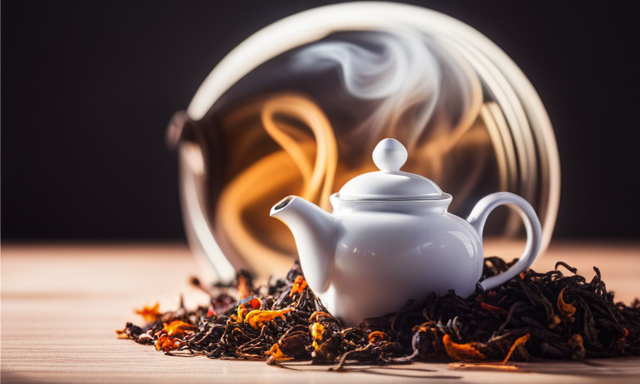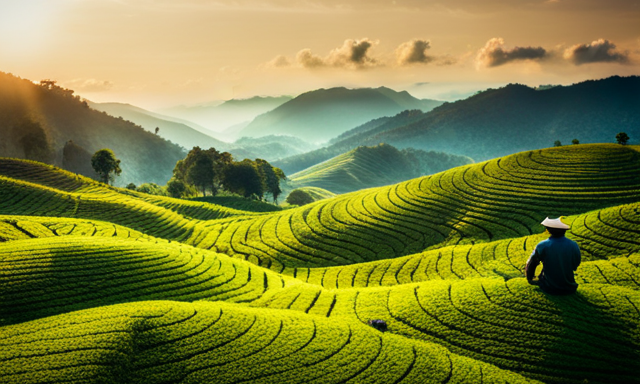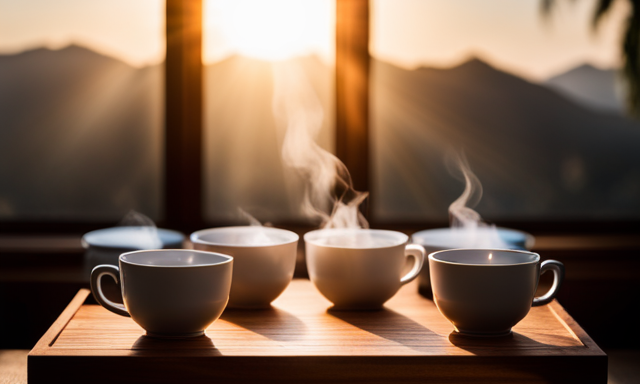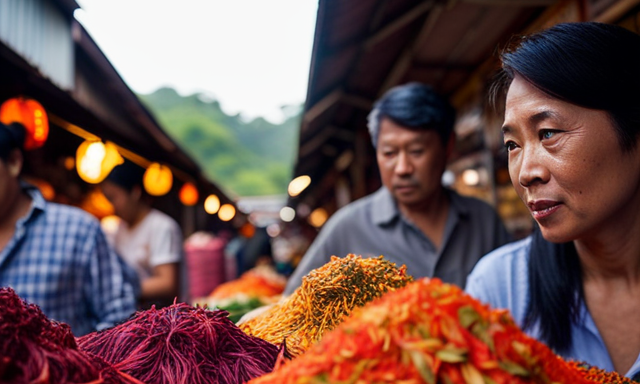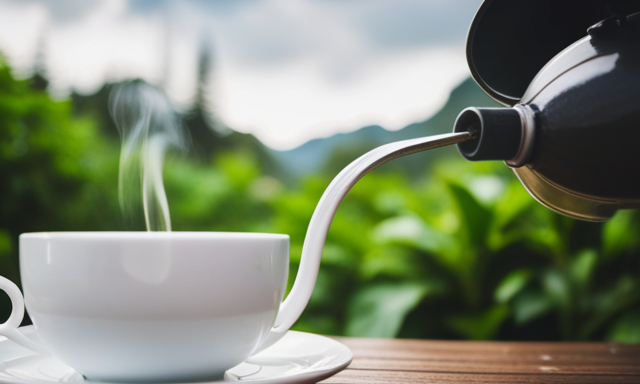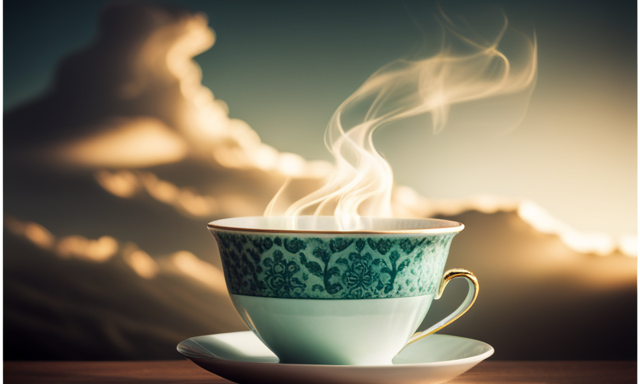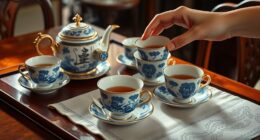I’ve always been a tea lover, and one of my favorite varieties is oolong tea. There’s something about its unique flavor profile that never fails to captivate me.
Recently, I stumbled upon an intriguing question: how many times can oolong tea be steeped? This question piqued my curiosity, and I delved into the world of oolong tea to find the answer.
In this article, I will guide you through the process of steeping oolong tea and explore the number of times it can be steeped to extract its delicate flavors. We will also delve into the different types of oolong tea and the health benefits it offers.
Armed with this knowledge, you’ll be able to enjoy the versatility of oolong tea and make the most out of every cup.
So, join me on this journey as we unravel the secrets of oolong tea and discover just how many times we can steep this delightful beverage.
Key Takeaways
- Oolong tea can be steeped multiple times, allowing for a more economical and enjoyable tea-drinking experience.
- The flavor and aroma of oolong tea undergo transformations with each subsequent steep, becoming more subtle and delicate.
- The steeping time should be adjusted for each steep to achieve the desired flavor balance.
- High-quality oolong tea leaves are ideal for multiple steepings and can provide a range of flavors and aromas.
Understanding Oolong Tea
Now, let me take you on a journey to understand the captivating world of oolong tea, where you’ll discover the secrets of its unique flavors and aromas.
Oolong tea is a traditional Chinese tea, made from partially oxidized tea leaves. It falls between green and black tea in terms of oxidation levels, resulting in a wide range of flavors and aromas.
This tea is known for its many health benefits, including improving digestion, boosting metabolism, and reducing the risk of heart disease. The combination of antioxidants and polyphenols in oolong tea contributes to these advantages.
Now, let’s delve into the steeping process and explore how many times oolong tea can be steeped to extract its full potential.
The Steeping Process
When it comes to steeping Oolong tea, two key factors to consider are the water temperature and the steeping time. The temperature of the water should be around 195-205°F (90-96°C) for most Oolong teas, but it may vary depending on the specific type of Oolong.
The steeping time can also vary, but generally ranges from 1 to 5 minutes. Additionally, the choice between using a teapot or a Gaiwan can affect the steeping process.
While a teapot is more commonly used for larger batches, a Gaiwan allows for better control over the steeping time and intensity of the tea.
Water Temperature and Steeping Time
To fully unlock the delicate flavors of oolong tea, you’ll want to dance with the perfect water temperature and steeping time, like a graceful tango between warmth and patience. Adjusting the water temperature and experimenting with steeping time can greatly impact the taste profile of your oolong tea. Here are three key considerations:
-
Water Temperature: Oolong tea is best steeped between 190°F (87°C) and 205°F (96°C). Lower temperatures bring out floral and fruity notes, while hotter temperatures enhance the tea’s rich and robust flavors.
-
Steeping Time: Oolong tea should be steeped for 1 to 5 minutes, depending on the desired strength. A shorter steeping time will result in a milder cup, while a longer steeping time will yield a stronger and more flavorful brew.
-
Experimentation: Don’t be afraid to adjust both the water temperature and steeping time to find your perfect balance. Every oolong tea is unique, and personal preferences vary.
By mastering the art of adjusting water temperature and experimenting with steeping time, you can create a customized oolong tea experience that suits your taste.
Now, let’s delve into the debate of teapot vs. gaiwan…
Teapot vs. Gaiwan
Let’s dive into the teapot vs. gaiwan debate and discover which vessel will elevate your oolong tea experience. Both the teapot and gaiwan have their own advantages and benefits when it comes to steeping oolong tea.
The teapot, with its larger size, allows for a longer steeping time and can maintain a consistent water temperature. This is especially beneficial for tightly rolled oolong teas that need more time to unfurl and release their flavors. The teapot also allows for multiple infusions, making it a great choice for those who prefer to steep their oolong tea multiple times.
On the other hand, the gaiwan, with its smaller size, allows for a more precise and controlled steeping process. Its wide opening and short steeping time help to fully extract the flavors of oolong tea, especially lighter and more delicate varieties. The gaiwan also offers a more intimate and immersive tea experience, allowing you to fully appreciate the aroma and taste of each infusion.
Now that we’ve explored the teapot and gaiwan, let’s move on to the first steep and unravel the secrets of unlocking the perfect flavor profile.
First Steep
You can steep oolong tea multiple times, each time revealing new layers of flavor and aroma, like peeling back the petals of a blooming flower. Understanding oolong tea and the steeping process is key to unlocking its full potential.
For the first steep, it’s important to rinse the tea leaves briefly with hot water to awaken their flavors and remove any impurities. Then, use water that’s around 190-200°F and steep the leaves for about 1-2 minutes. This initial steeping allows the tea leaves to slowly unfurl and release their delicate flavors. The resulting infusion will have a light golden hue with subtle floral and fruity notes.
As we move on to the second steep, the tea leaves will continue to evolve, creating a richer and more complex brew.
Second Steep
When it comes to the second steep of oolong tea, there are a few key points to consider. Firstly, the flavor and aroma of the tea will start to change as it’s steeped again. This can result in a milder taste and a more subtle aroma.
Secondly, it’s important to adjust the steeping time for the second steep. Since the tea leaves have already been partially steeped, they’ll release their flavors more quickly. Therefore, a shorter steeping time is typically recommended.
Overall, understanding these changes in flavor and aroma, as well as adjusting the steeping time, can help ensure a satisfying second steep of oolong tea.
Changes in Flavor and Aroma
As you steep oolong tea multiple times, its flavor and aroma undergo intriguing transformations. Oolong tea is known for its complex flavor profiles, which can range from fruity and floral to nutty and earthy.
With each subsequent steep, the flavors become more subtle and delicate, allowing different notes to shine through. This is due to the brewing techniques used for oolong tea, which involve gradually increasing the steeping time and temperature with each infusion. These changes in brewing parameters allow the tea leaves to release their flavors in a gradual and controlled manner.
Adjusting steeping time is crucial to maintaining the balance of flavors and preventing the tea from becoming bitter or astringent. By experimenting with different steeping times, you can find the perfect balance that suits your taste preferences.
Adjusting Steeping Time
When it comes to brewing oolong tea, adjusting steeping time is crucial for maximizing flavor extraction. The aroma and taste of oolong tea can vary significantly depending on how long it’s steeped. If you prefer a stronger and bolder flavor, you can increase the steeping time. On the other hand, if you want a lighter and more delicate taste, you can decrease the steeping time.
It’s important to experiment and find the perfect balance that suits your personal preferences. By adjusting the steeping time, you can control the intensity of the tea and create a cup that’s tailored to your liking.
Now, let’s delve into the fascinating world of the third steep and beyond, where even more unique flavors await.
Third Steep and Beyond
When it comes to the third steep and beyond, oolong tea undergoes a fascinating flavor evolution. I’ve experimented with different steeping times and discovered that the taste profile of the tea continues to evolve and develop. It’s interesting to observe how the flavors deepen or mellow with each subsequent steep. This allows me to fully appreciate the complexity and depth of oolong tea.
Flavor Evolution
During the steeping process, the flavor of oolong tea undergoes a delightful transformation. As the leaves unfurl and release their essence, the evolving flavors become more pronounced with each subsequent steep.
The initial steeping brings forth a delicate and floral aroma, accompanied by a light, mellow taste. With the second steep, the flavors deepen, revealing a more nuanced and complex profile.
It is during the third steep and beyond that the true magic happens. The flavors continue to evolve, becoming richer and more robust, with a lingering sweetness that’s simply divine.
To fully experience this flavor evolution, it’s important to use proper steeping techniques, such as using the correct water temperature and steeping time. By experimenting with steeping time, one can unlock the full potential of oolong tea’s incredible flavor profile.
Experimenting with Steeping Time
To truly unlock the full potential of oolong tea’s incredible flavor profile, you need to experiment with steeping time and discover the perfect balance for your taste buds. Here are three reasons why experimenting with steeping time is essential in exploring the diverse flavor profiles of oolong tea:
-
Strength: Steeping oolong tea for a shorter time results in a lighter, more delicate flavor, while a longer steeping time produces a bolder and more robust taste.
-
Aroma: Different steeping times release various aromatic compounds, allowing you to experience the unique scents and fragrances that oolong tea has to offer.
-
Complexity: By altering the steeping time, you can uncover the intricate layers of flavors present in oolong tea, ranging from fruity and floral to toasty and nutty.
By experimenting with steeping time, you can truly appreciate the depth and complexity of oolong tea’s flavor profiles.
Moving on to factors affecting steeping, let’s dive deeper into the quality of the tea leaves and water temperature.
Factors Affecting Steeping
Ironically, the number of times oolong tea can be steeped is influenced by various factors. The quality of the tea leaves, water temperature, steeping time, and the brewing vessel all play a significant role in determining the number of infusions. High-quality oolong tea leaves can be steeped multiple times, sometimes up to seven or eight infusions. The water temperature should be around 195-205°F (90-96°C) to extract the flavors effectively. Steeping time should be adjusted based on personal preference, with shorter steeping times resulting in a lighter flavor and longer steeping times producing a stronger brew. Using a clay or porcelain teapot can enhance the flavor and depth of the tea. Understanding these factors is crucial for maximizing the benefits of oolong tea and enjoying its complexity. Moving forward, I will provide some tips for re-steeping oolong tea.
Tips for Re-steeping Oolong Tea
When it comes to re-steeping oolong tea, there are a few key factors to consider. First, proper storage and preservation is essential to maintain the quality and flavor of the tea leaves.
Secondly, choosing the right tea leaves is crucial as different varieties have different re-steeping capabilities.
Lastly, understanding the brewing parameters such as water temperature and steeping time can help maximize the number of times oolong tea can be steeped. By paying attention to these factors, you can enjoy multiple flavorful infusions from your oolong tea.
Storage and Preservation
Proper storage and preservation of oolong tea ensures its flavors remain intact, allowing for multiple steepings that will undoubtedly delight tea enthusiasts. To prolong freshness, here are some essential tips:
- Store oolong tea in an airtight container to prevent exposure to moisture and air.
- Keep the container in a cool, dry place away from direct sunlight.
- Avoid storing oolong tea near strong odors, as it can absorb them easily.
- Consider using a ceramic or glass container instead of plastic, as it helps maintain the tea’s quality.
By following these storage guidelines, you can preserve the freshness and aroma of your oolong tea, ensuring a delightful tea-drinking experience.
Now, let’s move on to the next section and explore the art of choosing the right tea leaves.
Choosing the Right Tea Leaves
To find the perfect tea leaves, it’s all about trusting your taste buds and letting them be your guide. When choosing tea leaves for oolong tea, it’s important to consider the quality and origin of the leaves.
Look for leaves that are tightly rolled and have a vibrant color, indicating freshness. It’s also helpful to know the different types of oolong tea, such as traditional, floral, or fruity, as each type offers a unique flavor profile.
Experiment with different steeping techniques to enhance the taste of your oolong tea. Whether you prefer a shorter steeping time for a lighter flavor or a longer steeping time for a bolder taste, it’s all about finding what suits your palate.
Now, let’s dive into the world of different types of oolong tea and explore their distinctive characteristics.
Different Types of Oolong Tea
There are three main types of oolong tea: lightly oxidized, moderately oxidized, and darkly oxidized. Lightly oxidized oolong teas have a delicate and floral flavor, with a lower level of oxidation.
Moderately oxidized oolong teas have a richer and more robust flavor, with a medium level of oxidation.
Darkly oxidized oolong teas have a bold and earthy flavor, with a higher level of oxidation.
Each type of oolong tea offers a unique taste experience, allowing tea enthusiasts to explore a wide range of flavors.
Lightly Oxidized Oolong
Steeping a cup of lightly oxidized oolong tea is like embarking on a delightful journey of flavor that’ll captivate your taste buds and leave you craving for more.
This type of oolong tea is known for its delicate and subtle flavor profiles, which can range from floral and fruity to creamy and buttery. To fully experience its complex taste, it’s essential to use the right brewing techniques.
Here are a few tips to enhance your oolong tea experience:
- Use water that’s around 190-200°F to bring out the tea’s natural sweetness.
- Steep the tea leaves for 2-3 minutes for a light-bodied cup, or up to 5 minutes for a more robust flavor.
- Experiment with different steeping times to discover the nuances of the tea.
- Re-steep the leaves multiple times to extract every last drop of flavor.
Now, let’s move on to the next section and explore the world of moderately oxidized oolong teas.
Moderately Oxidized Oolong
Embarking on a cup of moderately oxidized oolong is like taking a sip of a sunset, with its warm and captivating flavors that dance on your palate. This type of oolong falls between the lightly and darkly oxidized varieties, striking a perfect balance between floral and fruity notes. Its flavor profile is complex, with hints of honey, orchid, and even stone fruit. To fully appreciate its nuances, it’s important to use the right brewing techniques. Steeping the leaves at a slightly higher temperature, around 190-200°F (88-93°C), for about 3-4 minutes will yield the best results. This allows the leaves to fully unfurl and release their delightful flavors. Moving on to the next section about darkly oxidized oolong, we explore even bolder tastes without losing the essence of oolong tea.
Darkly Oxidized Oolong
Indulge in the rich and captivating flavors of darkly oxidized oolong, as its bold taste transports you to a world of deep, amber hues and velvety smoothness.
Darkly oxidized oolong tea offers a wide range of flavor profiles that are truly exquisite. Its complex notes can range from fruity and floral to nutty and caramel-like, making each sip a delightful experience.
To fully appreciate the nuanced flavors, it’s essential to follow the correct brewing techniques. Start with water that’s around 190-200°F and steep the leaves for approximately 3-5 minutes. This allows the flavors to develop fully without becoming overpowering.
With each subsequent steeping, the flavors evolve, revealing new layers of complexity.
Now, let’s dive into the health benefits of oolong tea, where we explore its positive impact on our well-being.
Health Benefits of Oolong Tea
You’ll be amazed at how oolong tea can boost your metabolism and promote weight loss. It’s like a gentle breeze that ignites a flickering flame within your body, helping you burn calories more efficiently.
Oolong tea has been shown to aid in weight loss by increasing fat oxidation and improving metabolism. It contains polyphenols and catechins, which help to activate enzymes that enhance fat breakdown.
Additionally, oolong tea can improve digestion by reducing the absorption of fat and carbohydrates. This helps prevent overeating and promotes a healthy gut.
It also contains antioxidants that help fight free radicals and reduce inflammation.
Incorporating oolong tea into your daily routine can be an effective way to support your weight loss goals and improve overall digestion. So, why not explore the versatility of oolong tea and discover all the other wonderful benefits it has to offer?
Conclusion: Enjoying the Versatility of Oolong Tea
Now that we’ve explored the health benefits of oolong tea, let’s conclude by discussing the joy of experiencing its versatility.
As an avid tea lover, I’m constantly amazed by the wide range of flavor profiles that oolong tea offers. From floral and fruity to toasty and nutty, there’s something to please every palate.
What’s more, oolong tea can be steeped multiple times, allowing you to enjoy its complex flavors in different ways. The brewing techniques for oolong tea are just as diverse as its flavors, with variations in water temperature and steeping time yielding unique results.
Whether you prefer a delicate brew or a robust infusion, oolong tea has the flexibility to cater to your personal taste. So go ahead, explore the world of oolong tea and savor its rich flavors with every sip.
Frequently Asked Questions
What is the history and origin of oolong tea?
Oolong tea has a rich history and origin, originating in China and dating back centuries. It is a traditional Chinese tea that is partially fermented, giving it a unique flavor profile that falls between black and green tea.
Can oolong tea be consumed cold or is it best served hot?
Oolong tea can be enjoyed both hot and cold. While hot oolong tea offers a comforting and soothing experience, cold oolong tea is refreshing and perfect for warmer days. Additionally, oolong tea is known for its numerous health benefits.
Are there any specific brewing techniques for oolong tea?
To fully appreciate the benefits of oolong tea, it is essential to master the right brewing techniques. By following specific steps, you can unlock its rich flavor and experience its various health benefits.
How long should one wait between each steeping of oolong tea?
One should wait around 30 seconds to 1 minute between each steeping of oolong tea to allow the leaves to fully open up and release their flavors. The steeping temperature should be around 185-205°F.
Can oolong tea be flavored with other ingredients like fruits or herbs?
Yes, oolong tea can be flavored with fruits or herbs, adding a delightful twist to its taste. This not only enhances the flavor but also provides additional health benefits from the added ingredients. Who doesn’t love a refreshing and nutritious cup of flavored oolong tea?
Conclusion
In conclusion, Oolong tea is a versatile and delightful beverage that can be steeped multiple times to extract its rich flavors.
With each steep, the tea reveals different layers of taste and aroma, making it a truly unique experience.
From the first sip to the third and beyond, the journey of savoring Oolong tea is a delight for the senses.
So go ahead, indulge in this exquisite tea and let it transport you to a world of pure bliss. You won’t be able to resist its enchanting allure!

